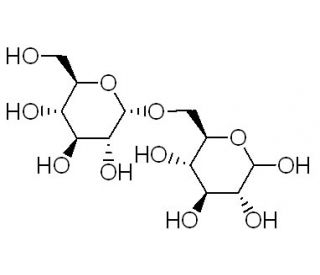
Click on image or enlarge button to enlarge

Isomaltose: sc-221770
Isomaltose (CAS 499-40-1)
Alternate Names:
6-O-α-D-Glucopyranosyl-D-glucose
CAS Number:
499-40-1
Molecular Weight:
342.30
Molecular Formula:
C12H22O11
For Research Use Only. Not Intended for Diagnostic or Therapeutic Use.
* Refer to Certificate of Analysis for lot specific data.
QUICK LINKS
Ordering Information
Description
Technical Information
Safety Information
SDS & Certificate of Analysis

Isomaltose serves as a versatile component in scientific research, playing a crucial role in various applications. It serves as a substrate for investigating glycosyltransferases and glycosidases, enzymes involved in the synthesis and breakdown of carbohydrates. Isomaltose aids in understanding the mechanisms employed by different enzymes engaged in glycosylation reactions. Moreover, it facilitates the examination of proteins responsible for carbohydrate metabolism, enabling researchers to delve into their structure and function.
References:
- Isomaltose formed by alpha-glucosidases triggers amylase induction in Aspergillus nidulans. | Kato, N., et al. 2002. Curr Genet. 42: 43-50. PMID: 12420145
- Isolation of isomaltose [6-(alpha-D-glucopyranosyl)D-glucose] from the culture filtrate of Penicillium chrysogenum Q-176. | GIRI, KV., et al. 1954. Arch Biochem Biophys. 51: 62-7. PMID: 13181460
- A kinetic model for the hydrolysis and synthesis of maltose, isomaltose, and maltotriose by glucoamylase. | Beschkov, V., et al. 1984. Biotechnol Bioeng. 26: 22-6. PMID: 18551581
- Kinetics of formation of maltose and isomaltose through condensation of glucose by glucoamylase. | Adachi, S., et al. 1984. Biotechnol Bioeng. 26: 121-7. PMID: 18551697
- Isomaltose production by modification of the fructose-binding site on the basis of the predicted structure of sucrose isomerase from ′Protaminobacter rubrum′. | Lee, HC., et al. 2008. Appl Environ Microbiol. 74: 5183-94. PMID: 18552181
- Kinetics of condensation of glucose into maltose and isomaltose in hydrolysis of starch by glucoamylase. | Shiraishi, F., et al. 1985. Biotechnol Bioeng. 27: 498-502. PMID: 18553698
- Construction of dextrin and isomaltose-assimilating brewer′s yeasts for production of low-carbohydrate beer. | Park, JY., et al. 2014. Biotechnol Lett. 36: 1693-9. PMID: 24737083
- Inhibition by maltose, isomaltose, and nigerose of the synthesis of high-molecular-weight D-glucans by the D-glucosyltransferases of Streptococcus sobrinus. | McAlister, D., et al. 1989. Carbohydr Res. 187: 131-8. PMID: 2526680
- Engineering of Escherichia coli to facilitate efficient utilization of isomaltose and panose in industrial glucose feedstock. | Abe, K., et al. 2017. Appl Microbiol Biotechnol. 101: 2057-2066. PMID: 27933453
- Ability of Saccharomyces cerevisiae MC87-46 to assimilate isomaltose and its effects on sake taste. | Tsutsumi, S., et al. 2019. Sci Rep. 9: 13908. PMID: 31558734
- Oxidation of isomaltose, gentiobiose, and melibiose by membrane-bound quinoprotein glucose dehydrogenase from acetic acid bacteria. | Kiryu, T., et al. 2020. Biosci Biotechnol Biochem. 84: 507-517. PMID: 31718466
- Efficient production of isomaltose and isomaltooligosaccharides from starch using 1,4- alpha -glucan 6- alpha -glucosyltransferase and isopullulanase. | Kitagawa, N., et al. 2021. Biosci Biotechnol Biochem. 85: 2450-2458. PMID: 34625793
- Discovery of a novel glucanohydrolase, 4- alpha -isomaltooligosylglucose 4-glucanohydrolase, that can be used for efficient production of isomaltose. | Kitagawa, N., et al. 2022. Carbohydr Res. 517: 108578. PMID: 35576629